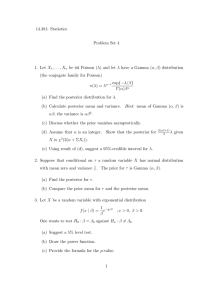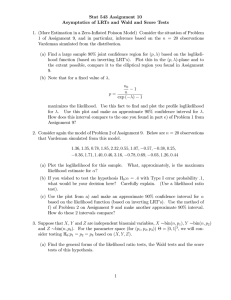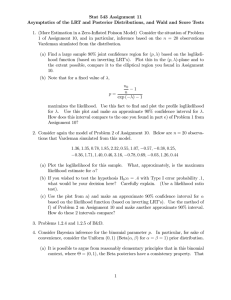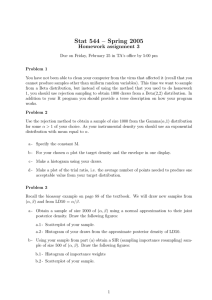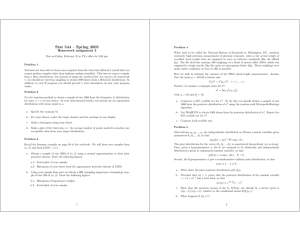Priors: Beta and Normal; Conjugate Priors Choosing
advertisement
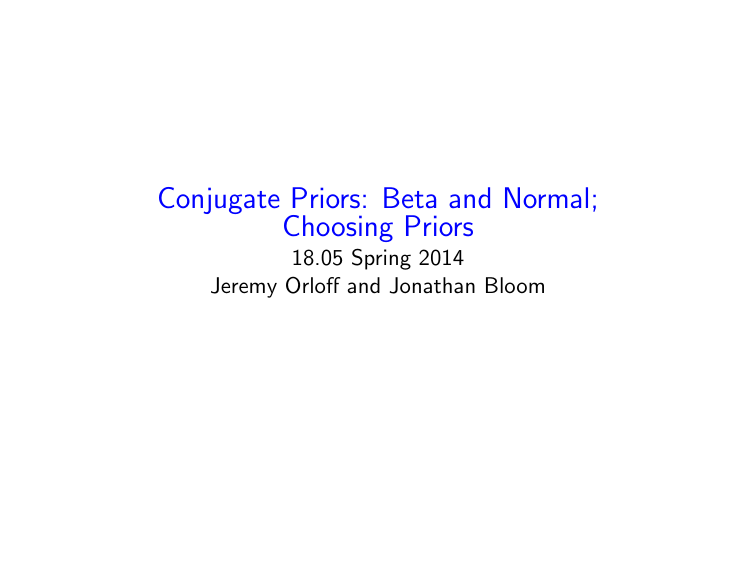
Conjugate Priors: Beta and Normal; Choosing Priors 18.05 Spring 2014 Jeremy Orloff and Jonathan Bloom Review: Continuous priors, discrete data ‘Bent’ coin: unknown probability θ of heads. Prior f (θ) = 2θ on [0,1]. Data: heads on one toss. Question: Find the posterior pdf to this data. hypoth. θ ± dθ 2 Total prior 2θ dθ 1 unnormalized likelihood posterior θ 2θ2 dθ f1 2 T = 0 2θ dθ = 2/3 posterior 3θ2 dθ 1 Posterior pdf: f (θ|x) = 3θ2 . June 1, 2014 2 / 17 Review: Continuous priors, continuous data Bayesian update tables with and without infinitesimals hypoth. prior likeli. unnormalized posterior θ f (θ) f (x | θ) f (x | θ)f (θ) posterior f (x | θ)f (θ) f (θ | x) = f (x) total 1 f (x) 1 hypoth. θ± dθ 2 total prior likeli. unnormalized posterior f (θ) dθ f (x | θ) dx f (x | θ)f (θ) dθ dx posterior f (x | θ)f (θ) dθ dx f (θ | x) dθ = f (x) dx f (x) dx 1 1 f (x) = f (x | θ)f (θ) dθ June 1, 2014 3 / 17 Board question: Romeo and Juliet Romeo is always late. How late follows a uniform distribution uniform(0, θ) with unknown parameter θ in hours. Juliet knows that θ ≤ 1 hour and she assumes a flat prior for θ on [0, 1]. On their first date Romeo is 15 minutes late. (a) find and graph the prior and posterior pdf’s for θ (b) find and graph the prior predictive and posterior predictive pdf’s of how late Romeo will be on the second data (if he gets one!). June 1, 2014 4 / 17 Solution: prior and posterior graphs Prior and posterior pdf’s for θ. June 1, 2014 5 / 17 Solution: predictive prior and posterior graphs Prior (red) and posterior (blue) predictive pdf’s for x2 June 1, 2014 6 / 17 Updating with normal prior and normal likelihood Data: x1 , x2 , . . . , xn drawn from N(θ, σ 2 )/ Assume θ is our unknown parameter of interest, σ is known. 2 Prior: θ ∼ N(µprior , σprior ) 2 In this case the posterior for θ is N(µpost , σpost ) with a= 1 2 σprior µpost = b= n , σ2 aµprior + bx̄ , a+b x̄ = x1 + x2 + . . . + xn n 2 = σpost 1 . a+b June 1, 2014 7 / 17 Board question: Normal-normal updating formulas a= 1 2 σprior b= n , σ2 µpost = aµprior + bx̄ , a+b 2 σpost = 1 . a+b Suppose we have one data point x = 2 drawn from N(θ, 32 ) Suppose θ is our parameter of interest with prior θ ∼ N(4, 22 ). 0. Identify µprior , σprior , σ, n, and x̄. 1. Use the updating formulas to find the posterior. 2. Find the posterior using a Bayesian updating table and doing the necessary algebra. 3. Understand that the updating formulas come by using the updating tables and doing the algebra. June 1, 2014 8 / 17 Concept question X ∼ N(θ, σ 2 ); σ = 1 is known. Prior pdf at far left in blue; single data point marked with red line. Which is the posterior pdf? 1. 2. 3. 4. Cyan Magenta Yellow Green June 1, 2014 9 / 17 Conjugate priors Priors pairs that update to the same type of distribution. Updating becomes algebra instead of calculus. hypothesis Bernoulli/Beta data prior likelihood posterior θ ∈ [0, 1] x beta(a, b) Bernoulli(θ) beta(a + 1, b) or beta(a, b + 1) θ x=1 c1 θa−1 (1 − θ)b−1 θ c3 θa (1 − θ)b−1 θ x=0 c1 θa−1 (1 − θ)b−1 1−θ c3 θa−1 (1 − θ)b Binomial/Beta θ ∈ [0, 1] x beta(a, b) binomial(N, θ) beta(a + x, b + N − x) (fixed N ) θ x c1 θa−1 (1 − θ)b−1 c2 θx (1 − θ)N −x c3 θa+x−1 (1 − θ)b+N −x−1 Geometric/Beta θ ∈ [0, 1] x beta(a, b) geometric(θ) beta(a + x, b + 1) θ x c1 θa−1 (1 − θ)b−1 θx (1 − θ) c3 θa+x−1 (1 − θ)b x 2 N(µprior , σprior ) Normal/Normal θ ∈ (−∞, ∞) (fixed σ 2 ) θ x c1 exp 2 −(θ−µprior ) 2 2σprior 2 N(θ, σ ) 2 c2 exp −(x−θ) 2σ 2 2 N(µpost , σpost ) (θ−µpost )2 c3 exp 2σ 2 post There are many other likelihood/conjugate prior pairs. June 1, 2014 10 / 17 Concept question: conjugate priors Which are conjugate priors? hypothesis data a) Exponential/Normal θ ∈ [0, ∞) θ b) Exponential/Gamma θ ∈ [0, ∞) c) Binomial/Normal (fixed N ) 1. none 5. a,b 2. a 6. a,c x x x θ x θ ∈ [0, 1] x θ x 3. b 7. b,c prior likelihood 2 N(µprior , σprior ) (θ−µ )2 c1 exp − 2σ2prior exp(θ) Gamma(a, b) exp(θ) c1 θa−1 e−bθ θe−θx prior θe−θx 2 N(µprior , σprior ) binomial(N, θ) (θ−µ )2 c1 exp − 2σ2prior c2 θx (1 − θ)N −x prior 4. c 8. a,b,c June 1, 2014 11 / 17 Board question: normal/normal For data x1 , . . . , xn with data mean x̄ = a= 1 2 σprior b= n , σ2 µpost = x1 +...+xn n aµprior + bx̄ , a+b 2 = σpost 1 . a+b Question. On a basketball team the average freethrow percentage over all players is a N(75, 36) distribution. In a given year individual players freethrow percentage is N(θ, 16) where θ is their career average. This season Sophie Lie made 85 percent of her freethrows. What is the posterior expected value of her career percentage θ? June 1, 2014 12 / 17 Concept question: normal priors, normal likelihood Blue = prior Red = data in order: 3, 9, 12 (a) Which graph is the posterior to just the first data value? 1. blue 4. yellow 2. magenta 5. green 3. orange 6. light blue June 1, 2014 13 / 17 Concept question: normal priors, normal likelihood Blue = prior Red = data in order: 3, 9, 12 (b) Which graph is posterior to all 3 data values? 1. blue 4. yellow 2. magenta 5. green 3. orange 6. light blue June 1, 2014 14 / 17 Variance can increase Normal-normal: variance always decreases with data. Beta-binomial: variance usually decreases with data. June 1, 2014 15 / 17 Table discussion: likelihood principle Suppose the prior has been set. Let x1 and x2 be two sets of data. Consider the following. (a) If the likelihoods f (x1 |θ) and f (x2 |θ) are the same then they result in the same posterior. (b) If x1 and x2 result in the same posterior then the likelihood functions are the same. (c) If the likelihoods f (x1 |θ) and f (x2 |θ) are proportional then they result in the same posterior. (d) If two likelihood functions are proportional then they are equal. The true statements are: 1. all true 2. a,b,c 3. a,b,d 4. a,c 5. d. June 1, 2014 16 / 17 Concept question Say we have a bent coin with unknown probability of heads θ. We are convinced that θ ≤ .7. Our prior is uniform on [0,.7] and 0 from .7 to 1. We flip the coin 65 times and get 60 heads. Which of the graphs below is the posterior pdf for θ? 1. green 4. magenta 2. light blue 5. light green 3. blue 6. yellow June 1, 2014 17 / 17 MIT OpenCourseWare http://ocw.mit.edu 18.05 Introduction to Probability and Statistics Spring 2014 For information about citing these materials or our Terms of Use, visit: http://ocw.mit.edu/terms.


